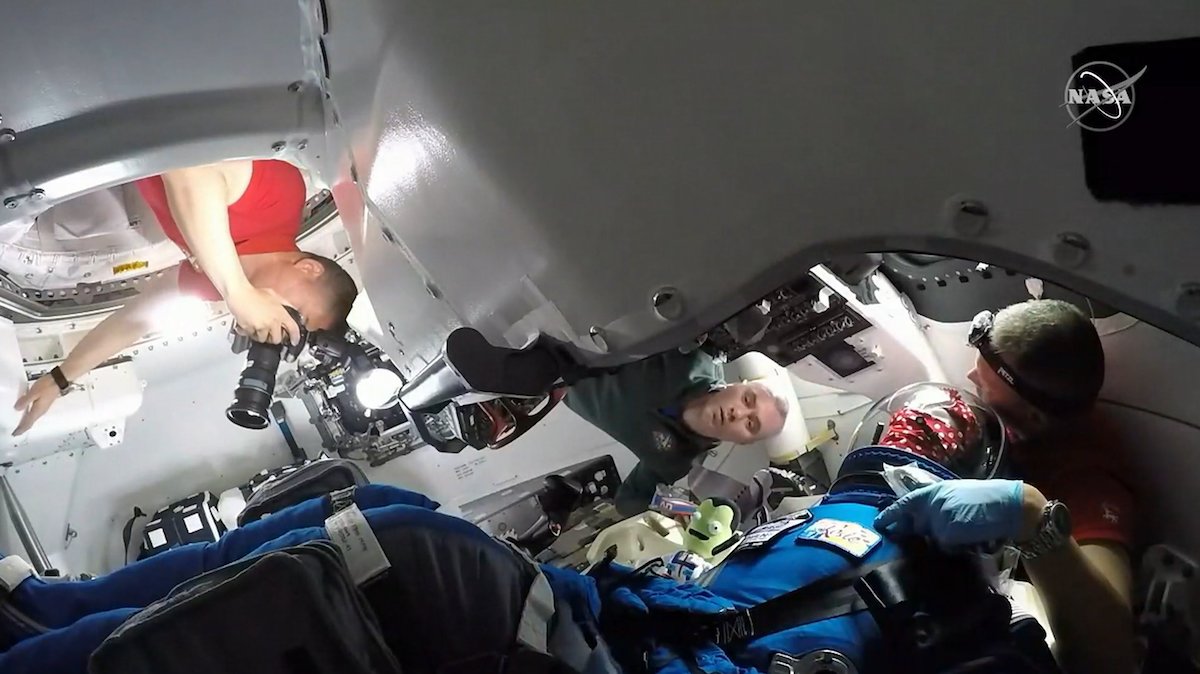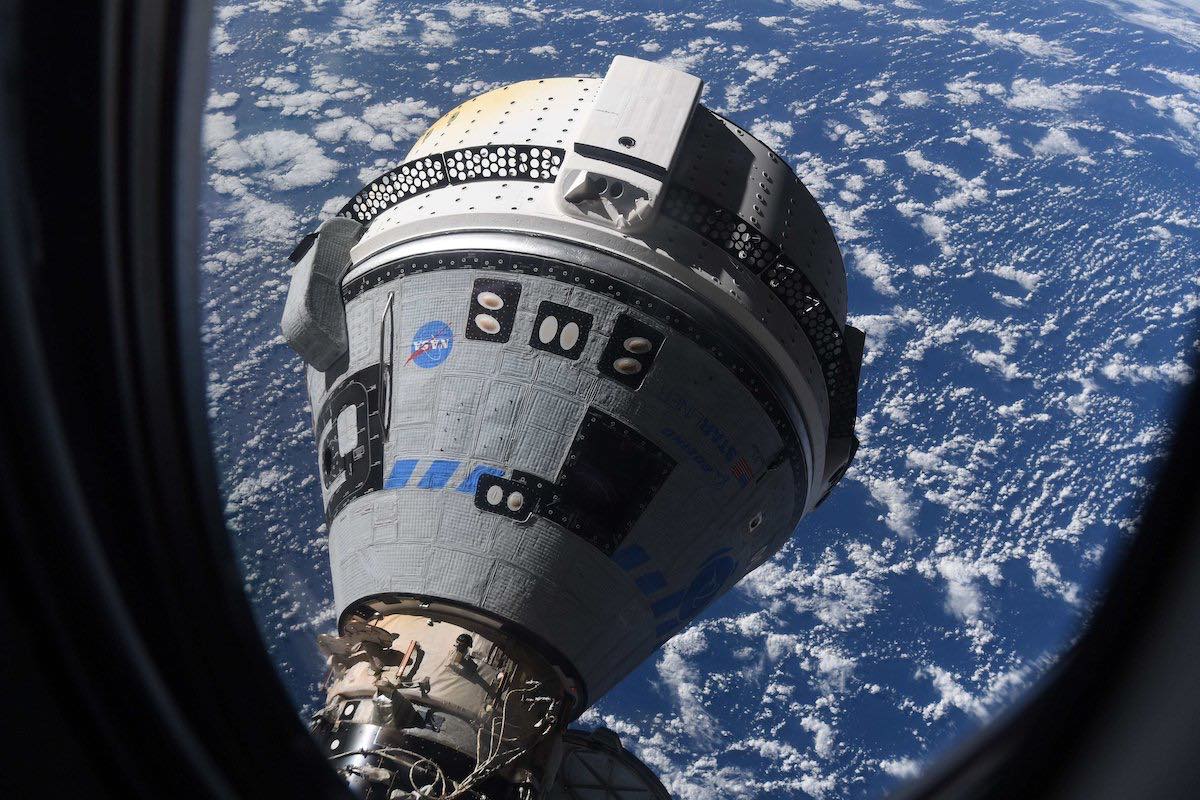EDITOR’S NOTE: Updated May 23 with landing weather forecast.

Astronauts on the International Space Station floated into Boeing’s Starliner capsule Saturday, becoming the first people to enter the spacecraft in orbit less than a day after it docked at the orbiting research complex for the first time.
The station astronauts will spend several days performing tests and unpacking cargo inside the Starliner spacecraft before it departs and returns to Earth on Wednesday.
NASA astronaut Bob Hines became the first person to enter a Starliner spacecraft in orbit after opening the capsule’s forward hatch at 12:04 p.m. EDT (1604 GMT) Saturday. Two of his crewmates, NASA astronaut Kjell Lindgren and Russian cosmonaut Denis Matveev, joined him inside the spacecraft a few minutes later.
The crew members initially wore masks and goggle to protect against potential floating particles inside the Starliner spacecraft. The protective gear is usually worn by space station astronauts when entering a new spacecraft or new module for the first time.
The astronauts removed their protective gear after a few minutes. They snapped photos and inspected the inside of the capsule, and broadcast a brief video tour of the Starliner crew cabin.
“Welcome to Starliner, for the very first time ever in space,” Hines said.
The Starliner spacecraft docked at the forward port of the station’s Harmony module at 8:28 p.m. EDT Friday (0028 GMT Saturday). The capsule completed the automated link-up after holding position near the station longer than planned, giving time for mission control to resolve an issue with its docking mechanism.
“It was really spectacular to see this beautiful vehicle arrive here yesterday,” Hines said.
The Starliner spacecraft “parked out on the doorstep for a little while resolving some minor issues, but these are the kinds of things we expect in flight test, and that is why we do tests,” Hines said Saturday. “If we didn’t find something like that, we’re probably doing something wrong. So it was a highly successful mission yesterday. It was great to have Starliner on-board.”
NASA astronaut Bob Hines shows off the interior of the Starliner crew module docked at the International Space Station. https://t.co/aw0ThNxJbJ pic.twitter.com/avxSEZzbAa
— Spaceflight Now (@SpaceflightNow) May 21, 2022
Hines, Lindgren, and crewmates Jessica Watkins and Samantha Cristoforetti flew to the International Space Station last month on a SpaceX Dragon spacecraft. Their launch and docking marked the fourth operational flight of SpaceX’s crew capsule carrying astronauts to the space station, and the seventh Dragon crew flight overall, including a 2020 test flight and two all-commercial human spaceflight missions.
Boeing’s Starliner program, meanwhile, is running years behind SpaceX’s Dragon spacecraft. A 2019 unpiloted test flight was cut short by software problems, and the spacecraft returned to Earth without docking at the space station. Boeing and NASA agreed to launch a second unpiloted demo mission — called Orbital Flight Test-2 — but the launch was delayed from last August by problems with valves in the spacecraft’s propulsion system.
Boeing took $595 million in accounting charges to pay for the OFT-2 mission and associated delays.
The OFT-2 mission finally launched Thursday from Cape Canaveral aboard a United Launch Alliance Atlas 5 rocket. NASA and Boeing managers approved the Starliner spacecraft for approach to the space station Friday, following several technical issues with thrusters and the capsule’s cooling system.
NASA awarded SpaceX and Boeing multibillion-dollar contracts in 2014 to finish the design and development of the Dragon and Starliner vehicles. In total, NASA has signed commercial crew contracts with Boeing valued at more than $5.1 billion, and $3.1 billion in contracts covering similar work with SpaceX.
NASA’s commercial crew program was set up to provide independent U.S. astronaut access to the space station after the retirement of the space shuttle. For nine years after the last shuttle flight until SpaceX’s capsule came online, NASA astronauts rode Russian Soyuz spacecraft to and from the space station.
“Back in 2014, NASA awarded the commercial crew contracts, and this is the day that they envisioned, where we have three human-rated vehicles docked to the space station right now,” Hines said. “So we have the Soyuz docked on the MLM (Multipurpose Laboratory Module), and then we have a Dragon right above us, and the Starliner right behind us.
“This is a momentous day in NASA’s history, and just paving the way for the future as we start enabling commercial flights here in low Earth orbit while NASA pivots to the moon and eventually on to Mars.”

Hines and Lindgren plan several tests inside the Starliner capsule while it is docked at the space station. They will perform communications checks inside the Starliner spacecraft, and unpack about 500 pounds of cargo, then replace it with about 600 pounds of cargo for return to Earth.
The Starliner is scheduled to undock from the station at 2:36 p.m. EDT (1836 GMT) Wednesday, then back away to a safe distance from the complex before a braking burn at 6:02 p.m. EDT (2202 GMT) to drop out of orbit.
The crew module, designed for reuse, will jettison its disposable service module and re-enter the atmosphere on a southwest to northeast trajectory, then deploy parachutes and inflate airbags to cushion for landing at White Sands Missile Range in New Mexico at 6:49 p.m. EDT (2249 GMT).
As of Monday, the weather forecast for Wednesday was “go” for landing of the Starliner spacecraft, according to a Boeing spokesperson. The forecast calls for scattered clouds, visibility of greater than 6 miles, and east-southeast winds of 8 knots peaking to 12 knots.
The OFT-2 mission is a precursor before NASA clears astronauts to fly on the next Starliner mission to the International Space Station. After landing, Boeing will transport the Starliner capsule back to NASA’s Kennedy Space Center for refurbishment and use on a future crew mission.
Email the author.
Follow Stephen Clark on Twitter: @StephenClark1.
